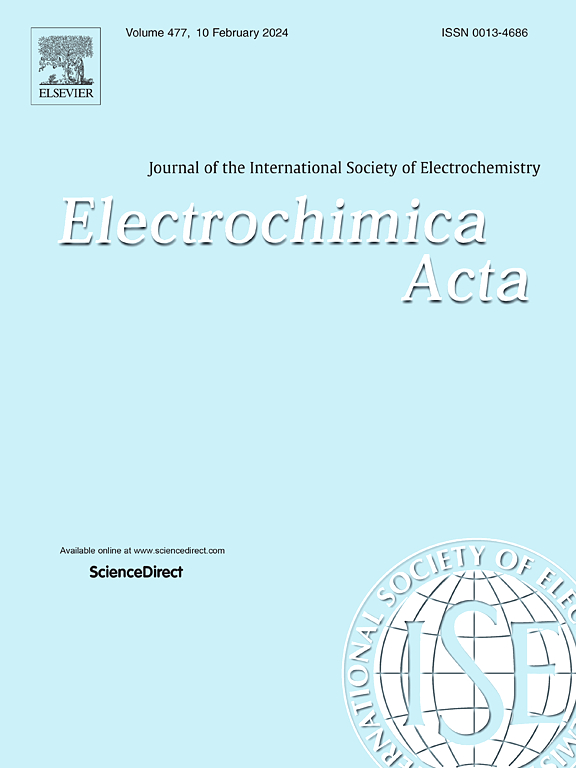自支撑Ni (OH)2模板在高能量密度超级电容器中向硫化异质界面纳米球方向生长mo掺杂crni - mof
IF 5.6
3区 材料科学
Q1 ELECTROCHEMISTRY
引用次数: 0
摘要
金属有机骨架(mof)由于其可调节的孔隙结构、丰富的离子扩散途径和可获得的活性位点而成为超级电容器极具前景的材料。然而,其固有的低电导率和有限的倍率性能限制了实际电化学性能的突破。本文提出了一种三步水热合成策略,通过在泡沫镍上原位生长Ni (OH)2纳米片阵列作为导电支架来制备三维异质结构,然后原位沉积mo掺杂CrNi-MOF (MIL系列),获得多孔蜂窝状结构(HC2N1M1)。随后的硫化处理进一步将杂化结构转化为多孔纳米球基异质结构(HC2N1M1-S120),显示出受控的形态演化。优化后的HC2N1M1-S120材料在1 a g-1时具有956.7 C g-1的高比电容,并且由于其独特的结构层次和多种电荷传输途径,在8000次循环中具有76%的容量保持率,表现出优异的循环稳定性。此外,用该电极(HC2N1M1-S120//AC)组装的非对称超级电容器器件在800 W kg-1的功率密度下获得了58.4 Wh kg-1的能量密度,显示了其在高性能储能系统中的潜力。本研究展示了元素掺杂与多维结构工程相结合的协同策略,从而为通过合理的材料设计开发高性能超级电容器的先进电极材料开辟了新的途径。本文章由计算机程序翻译,如有差异,请以英文原文为准。


Self-supported Ni (OH)2-templated growth of Mo-doped CrNi-MOFs toward Sulfurized heterointerfaced nanospheres for high-energy-density supercapacitors
Metal-organic frameworks (MOFs) have emerged as promising electrode materials for supercapacitors, owing to their tunable pore architectures, abundant ion diffusion pathways, and accessible active sites. However, their inherent low conductivity and restricted rate capability limit the breakthrough of practical electrochemical performance. Herein, a three-step hydrothermal synthesis strategy is developed to fabricate a three-dimensional heterostructure by in situ growth of Ni (OH)2 nanosheet arrays on nickel foam as a conductive scaffold, followed by in situ deposition of Mo-doped CrNi-MOF (MIL series), achieving a porous honeycomb-like architecture (HC2N1M1). Subsequent sulfidation treatment further converts the hybrid structure into a porous nanosphere-based heterostructure (HC2N1M1-S120), demonstrating controlled morphological evolution. The optimized HC2N1M1-S120 material delivers a high specific capacitance of 956.7 C g-1 at 1 A g-1 and demonstrates exceptional cycling stability with 76 % capacity retention over 8000 cycles, benefiting from its unique structural hierarchy and multiple charge transport pathways. Furthermore, the asymmetric supercapacitor device assembled with this electrode (HC2N1M1-S120//AC) achieves a remarkable energy density of 58.4 Wh kg-1 at a power density of 800 W kg-1, showcasing its potential for high-performance energy storage systems. This study has demonstrated a synergistic strategy combining elemental doping and multidimensional structural engineering, thereby paving a new pathway for developing advanced electrode materials toward high-performance supercapacitors through rational material design.
求助全文
通过发布文献求助,成功后即可免费获取论文全文。
去求助
来源期刊

Electrochimica Acta
工程技术-电化学
CiteScore
11.30
自引率
6.10%
发文量
1634
审稿时长
41 days
期刊介绍:
Electrochimica Acta is an international journal. It is intended for the publication of both original work and reviews in the field of electrochemistry. Electrochemistry should be interpreted to mean any of the research fields covered by the Divisions of the International Society of Electrochemistry listed below, as well as emerging scientific domains covered by ISE New Topics Committee.
 求助内容:
求助内容: 应助结果提醒方式:
应助结果提醒方式:


